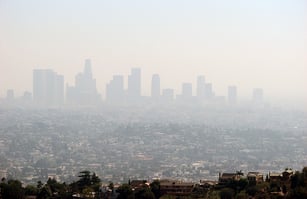 The Environmental Protection Agency (EPA) announced on February 7. 2024 its decision to tighten one the National Ambient Air Quality Standard (NAAQS) for particulate matter less than or equal to 2.5 microns; (PM-2.5; also call “fines” in contrast to larger particulates). This decision completes EPA’s reconsideration of a decision in 2020 not to adjust the PM-2.5 requirements (I wrote about that decision HERE); the change reflects in part the changed priorities between the Trump and Biden administrations. The rest of this note summarizes NAAQS issues as they apply to PM-2.5.
The Environmental Protection Agency (EPA) announced on February 7. 2024 its decision to tighten one the National Ambient Air Quality Standard (NAAQS) for particulate matter less than or equal to 2.5 microns; (PM-2.5; also call “fines” in contrast to larger particulates). This decision completes EPA’s reconsideration of a decision in 2020 not to adjust the PM-2.5 requirements (I wrote about that decision HERE); the change reflects in part the changed priorities between the Trump and Biden administrations. The rest of this note summarizes NAAQS issues as they apply to PM-2.5.
What is EPA’s responsibility to establish and administer NAAQSs?
The Clean Air Act (CAA) requires EPA to identify and list “conventional” air pollutants that may cause or contribute to air pollution, which may reasonably be anticipated to endanger public health or welfare. Accordingly, EPA evaluates atmospheric concentrations of potential pollutants, and sets NAAQSs for atmospheric (ambient air) concentrations. EPA presently sets NAAQSs (primary and secondary standards) for oxides of sulfur (SOX), as well as for carbon monoxide (CO), lead, nitrogen dioxide, ozone, and particulates (PM-10 and PM-2.5). NAAQSs must “accurately reflect the latest scientific knowledge useful in indicating the kind and extent of all identifiable effects on public health or welfare….” CAA requires EPA to re-evaluate each NAAQS at least every 5 years, but EPA often misses these deadlines. For example, the review that led to the 2020 determination and this 2024 reconsideration began following the last completed review in 2014.
What are the national particulate standards?
EPA promulgated its first CAA particulate standards in 1971, and has slowly expanded and tightened PM regulations over more than fifty years. EPA initially set standards for PM-10, but added PM-2.5 requirements in 1997. EPA provides both primary standards (which provide public health protection, including the health of sensitive populations such as asthmatics, children, and the elderly) and secondary standards (which provide public welfare protection, including protection against decreased visibility and damage to animals, crops, vegetation, and buildings). Since 2013, NAAQSs applicable to PM have been:
- PM-10
- primary and secondary standards (same limit) 24-hour average 150 micrograms per cubic meter (µg/m3)
- PM-2.5
- Primary standard - annual average 12 µg/m3
- Secondary standard - annual average µg/m3
- Primary and secondary standards (same limit) - 24-hour average 35 µg/m3
In its reconsideration decision, EPA cites recent and developing scientific evidence and tightens the PM-2.5 primary standard from 12 to 9 µg/m3. The decision reaffirms the other PM standards without change.
What happens now?
EPA’s decision will become effective 60 days after its publication in the Federal Register, so publication during February 2024 means effective date in April. Appeals are likely, of EPA’s decision to tighten the primary PM-2.5 standard as well as its reaffirmation of the other PM standards. Absent successful reviews, CAA and EPA regulations provide local and state air quality agencies one year to self-designate areas as being in or out of attainment with the new standard, based on monitoring data (note that “exceptional events” can be identified and excluded from the data; this is important for PM-2.5 data because wildfires are major sources of fine particulates). Recent monitoring data suggest that a number of metropolitan areas in western states will shift to non-attainment, such as Denver and Las Vegas. As non-attainment designations are finalized, air quality agencies will be required to design and implement additional measures to reduce emissions --- tighter emissions limits as well as possible controls (and incentives) affecting land use and equipment operation.
Self-Assessment Checklist
Does the organization conduct activities that emit particulates from stationary sources?
- If so, are any of these activities characterized as “major sources” that are subject to the most extensive permit requirements?
- If so, are any of these activities in an area in which ambient concentrations may fail to attain the revised NAAQS, where stricter standards may be imposed?
Where do I go for more information?
About the Author
 Jon Elliott is President of Touchstone Environmental and has been a major contributor to STP’s product range for over 30 years.
Jon Elliott is President of Touchstone Environmental and has been a major contributor to STP’s product range for over 30 years.
Mr. Elliott has a diverse educational background. In addition to his Juris Doctor (University of California, Boalt Hall School of Law, 1981), he holds a Master of Public Policy (Goldman School of Public Policy [GSPP], UC Berkeley, 1980), and a Bachelor of Science in Mechanical Engineering (Princeton University, 1977).
Mr. Elliott is active in professional and community organizations. In addition, he is a past chairman of the Board of Directors of the GSPP Alumni Association, and past member of the Executive Committee of the State Bar of California's Environmental Law Section (including past chair of its Legislative Committee).
You may contact Mr. Elliott directly at: tei@ix.netcom.com
